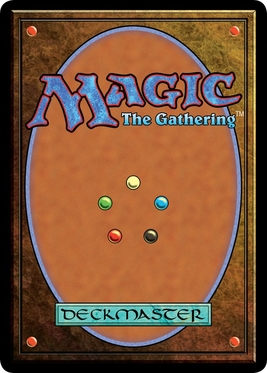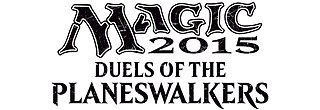
Magic: The Gathering is a tabletop and digital collectible card game created by Richard Garfield. Released in 1993 by Wizards of the Coast, Magic was the first trading card game and had approximately fifty million players as of February 2023. Over twenty billion Magic cards were produced in the period from 2008 to 2016, during which time it grew in popularity. As of the 2022 fiscal year, Magic generates over $1 billion in revenue annually.
The Multiverse is the shared fictional universe depicted on Magic: The Gathering cards, novels, comics, and other supplemental products. Though Magic is a strategy game, an intricate storyline underlies the cards released in each expansion. On the cards, elements of this multiverse are shown in the card art and through quotations and descriptions on the bottom of most cards. Novels and anthologies published by HarperPrism and Wizards of the Coast (WOTC), and the comic books published by Armada Comics expand upon the settings and characters hinted at on the cards. WOTC also publishes a weekly story in the Magic Fiction column, previously known as Official Magic Fiction and Uncharted Realms.
Several video games based on the Magic: The Gathering franchise exist for multiple systems. Some have attempted to translate the card game to electronic play nearly exactly; others have taken more liberties and drawn more from the setting than the actual rules of the card game. Benefits of successful video game versions of the card game include convenience, practice, and challenge. However, artificial intelligence for a game such as Magic is an extremely hard problem, and such software usually must be continuously updated to stay current with recently released card sets. Video game versions often expand on artwork, and may include unique cards that rely on randomness, effects which would be difficult or annoying to duplicate in real life.
The collectible card game Magic: The Gathering has released compilation sets, reprint sets, and box sets over its history. These are distinct from core sets and expansion sets, the most heavily marketed sources of new cards. With the exception of Chronicles, reprint sets generally do not affect tournament legality in supported formats; for example, cards reprinted in the Modern Masters reprint set, while legal for tournament play, did not necessarily cause the card to be included in the "Standard" environment.

Magic: The Gathering is a video game published by MicroProse in March 1997 based on the collectible card game Magic: The Gathering. It is often referred to as Shandalar after the plane of Shandalar, where the game takes place. The player must travel the land and fight random enemies to gain cards, and defeat five wizards representing the five colors. The player must prevent one color from gaining too much power, and defeat the planeswalker Arzakon, who has a deck of all five colors. Adventure and role-playing elements are present, including inventory, gold, towns, dungeons, random battles, and character progression in the form of new abilities and a higher life point total. An oversized version of Aswan Jaguar was included in the game box.
The rules of Magic: The Gathering were originally developed by the game's creator, Richard Garfield, and accompanied the first version of the game in 1993. The rules of Magic have been changed frequently over the years by the manufacturer, Wizards of the Coast, mostly in minor ways. However, major rules overhauls have also been done a few times.

Magic: The Gathering – Duels of the Planeswalkers 2013 is a video game based on the popular collectible card game of the same name, first published by Wizards of the Coast in 1993. The game was released on June 20, 2012, via Steam, Xbox Live Arcade, the PlayStation Network, and iPad, and is the third game in the Magic: The Gathering – Duels of the Planeswalkers series. The gameplay follows that of the original card game, however within a more restrained framework. It received mainly positive reviews and was number one in the PlayStation Network sales for June. The sequel, Magic: The Gathering – Duels of the Planeswalkers 2014, was released in 2013.
Theros is a set of three expansions to the Magic: The Gathering game, consisting of the sets Theros, Born of the Gods and Journey into Nyx. The setting was later used for a Dungeons & Dragons sourcebook, Mythic Odysseys of Theros (2020). The lore and aesthetics of the game setting was based on Greek mythology.

Magic 2015 – Duels of the Planeswalkers is a video game based on the collectible card game of the same name, first published by Wizards of the Coast in 1993. The game was released in July 2014 on PC (Steam), Xbox 360, iPad (iTunes), and Android devices. An Xbox One version was released in November 2014. It is the fifth game in the Magic: The Gathering – Duels of the Planeswalkers series. The gameplay follows that of the original card game, however within a more restrained framework. The game, like all the previous installments, is priced $10 on most platforms. On the iPad, the game is free for the first realm but has in-app purchases for the remaining realms, more cards and additional features.
Kaladesh is a Magic: The Gathering expansion block consisting of the sets Kaladesh and Aether Revolt. The block debuted with the release of Kaladesh on September 30, 2016. The block is set on the plane of Kaladesh, the original home of planeswalker Chandra Nalaar, and features an emphasis on artifacts, their creators and the magical aether which powers them.
Amonkhet is a Magic: The Gathering expansion block consisting of the sets Amonkhet and Hour of Devastation. Amonkhet was released on April 28, 2017, and Hour of Devastation was released on July 14, 2017. The eponymous new plane has an ancient Egyptian theme, and features concepts like mummies and embalming.

Mythic Odysseys of Theros is a sourcebook that details the Theros campaign setting for the 5th edition of the Dungeons & Dragons fantasy role-playing game published in June 2020. The plane was originally created for the Magic: The Gathering collectible card game and first appeared in the card set Theros, which was released in September 2013. It is inspired by Greek mythology and has a powerful pantheon of Gods that are present and active in both the world and the lives of the player characters.

Throne of Eldraine is a Magic: The Gathering expansion set. It is not part of a block. It was released on October 4, 2019. The sets development codename is "Archery", and its expansion code is ELD. MTG Arena also officially launched with this set.
Strixhaven: School of Mages is a Magic: The Gathering expansion set. It is not part of a block. The set was released in April 2021.
Kaldheim is the 86th Magic: The Gathering expansion and is not part of a block. It is set on the plane of the same name. It was released on February 5, 2021. It also became available in MTG Arena on January 28, 2021.
Guilds of Ravnica is the 79th Magic: The Gathering expansion; while it is not part of a block, this set is functionally the first part of a Ravnica focused storyline set on the plane of Ravnica. It was released on October 5, 2018.
Zendikar Rising is the 85th Magic: The Gathering expansion and is not part of a block. It is set on the plane of Zendikar. It was released on September 25, 2020. The sets development codename is "Diving", and its expansion code is ZNR.
Ravnica Allegiance is the 80th Magic: The Gathering expansion; while it is not part of a block, this set is functionally the second part of a Ravnica focused storyline set on the plane of Ravnica. It was released on January 25, 2019.
War of the Spark is the 81st Magic: The Gathering expansion; while it is not part of a block, this set is functionally the third part of a Ravnica-focused storyline set on the plane of Ravnica. It was released on May 3, 2019. It also became available in MTG Arena on April 25, 2019.
Dungeons & Dragons: Adventures in the Forgotten Realms is an expansion set for Magic: The Gathering (Magic) released in July 2021. The world of the Forgotten Realms was created by game designer Ed Greenwood around 1967 as a paracosm for his childhood stories and premiered as a campaign setting for the Dungeons & Dragons (D&D) fantasy role-playing game in the Forgotten Realms Campaign Setting (1987). This expansion set is the third collaboration between Magic and D&D; both teams are part of Wizards of the Coast.






